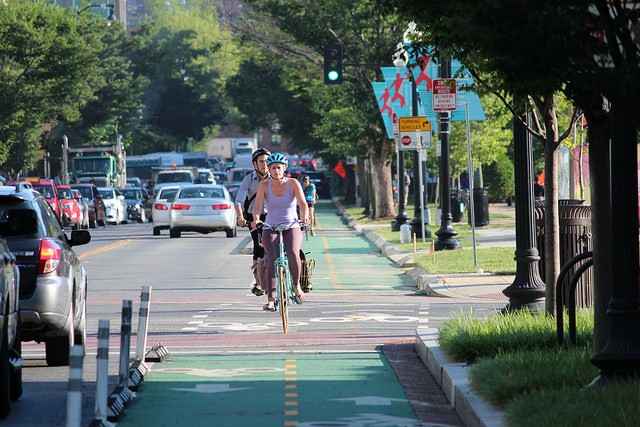People in DC love to walk and bike to work, but employee benefits focus on parking

Image by Matt Johnson licensed under Creative Commons.
Walking or riding a bike is a more popular way to get to work than in DC than just about any other major US city, but employee benefits for these modes pale in comparison to what employers provide for parking or taking transit. What would happen if people could swap parking benefits for cash?
DC has more people who bike to work than San Francisco, New York, and Chicago. In fact, according to the 2015 American Community Survey, 14% of DC residents walked to work and 4.1% biked, a total of 18.1%. Only Boston had a larger percentage: there, 16.7% of people walked and 1.6% biked, a total of 18.3%.
…but employers are much more likely to encourage driving and transit
As of 2016, most employers in DC must allow employees to use their own pre-tax dollars to buy transit fares. In addition, employers can provide their employees with a commuting benefit in the form of a pre-tax subsidy that covers up to $255 a month for parking and another $255 for public transit. When it comes to biking, though, employers can offer only a $20 per month reimbursement—and it cannot be combined with money for either parking or transit. Walking is not eligible for a tax-free commuter benefit.
This means employees might have to make a choice: Do they want upwards of $500 per month for parking and transit, $20 per month to bike (if their employer offers it, but few do), or zero dollars to walk? Clearly, one thing that happens here is that employers give an incentive to drive to work.
When employers subsidize parking, either by paying for it themselves or letting workers put money from their checks aside for these amenities before taxes, they incentivize driving. These subsidies effectively drive up congestion and leave governments with fewer tax dollars to put toward repairing bridges and roads.
The case for paying people to walk and bike—not drive—to work
What if employees who are eligible for parking and transit benefits could opt out of them and instead just get extra income equal to the value of the benefit? This solution, known as “parking cash-out,” would likely result in more people walking or biking to work.
Employees who don’t get an incentive to drive are much more likely to walk or bike to work. According to Dr. Kenneth Joh of the Metropolitan Washington Area Council of Governments, “walking and biking trip shares were about three times higher for DC workers who were not offered free parking by their DC employer compared to DC workers who were eligible for free parking.”
Cheryl Cort at the Coalition for Smarter Growth notes that commuters who walk or bike are more likely to actually enjoy their commute than those who take the train or drive. And commuters who walk or bike to work not only do so to save money, but also to stay in shape.
Fewer people driving could help cut down on congestion as well as keep employees from feeling like they’re leaving money on the table when they choose not to use their parking benefit.
Of course, employers could simply offer this benefit if they wanted to— that’s how parking and transit benefits work now. But another option would be to require employers to offer an equivalent benefit to people use don’t drive or use transit to get to work.
DC Councilmember Charles Allen has introduced a bill that would do just that. It would require any employer that offers to pay for parking or transit for employees to get to work also provide the option to use an equivalent benefit not to drive. If it passes, DC would be the first major city to have an enforceable parking cash-out program.
As traffic congestion in DC continues to rank among the worst in the country and WMATA marches ahead with SafeTrack, making parking cash-out happen could very likely be a bright spot for transportation in the region.
Correction: The first version of this post said that Charles Allen's bill would require employers who pay for parking or transit benefits to also provide a parking cash-out option. The law only applies to employers who offer parking benefits.
